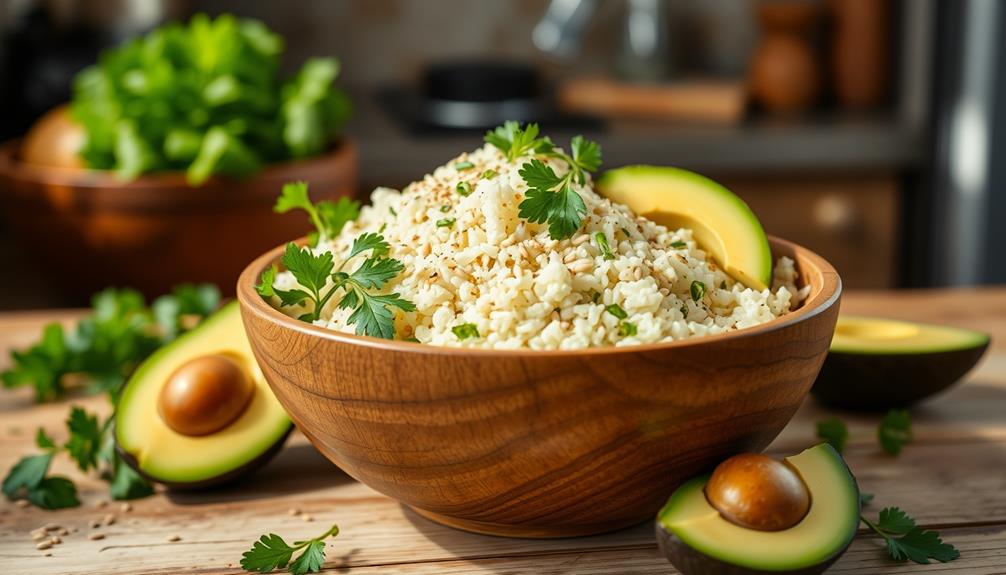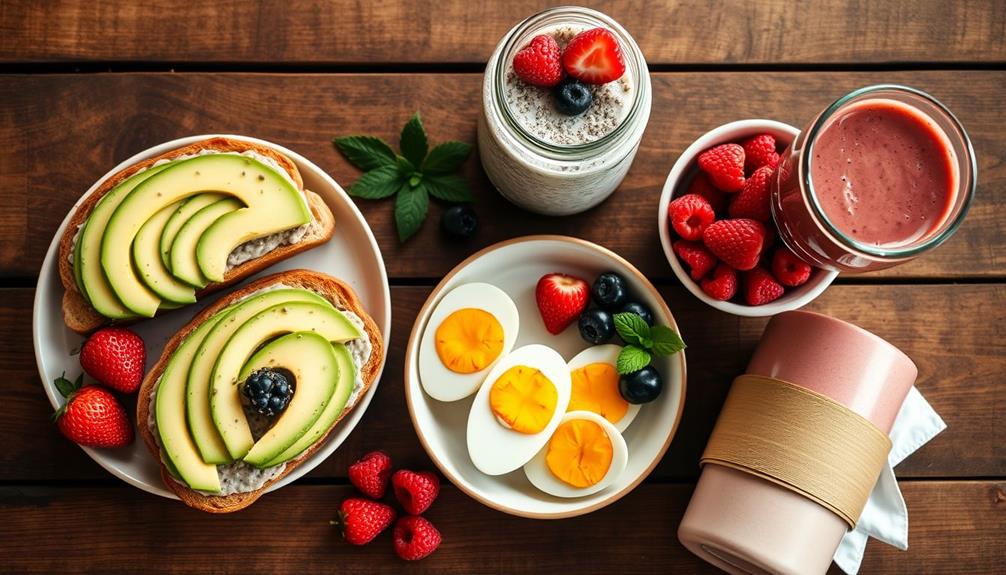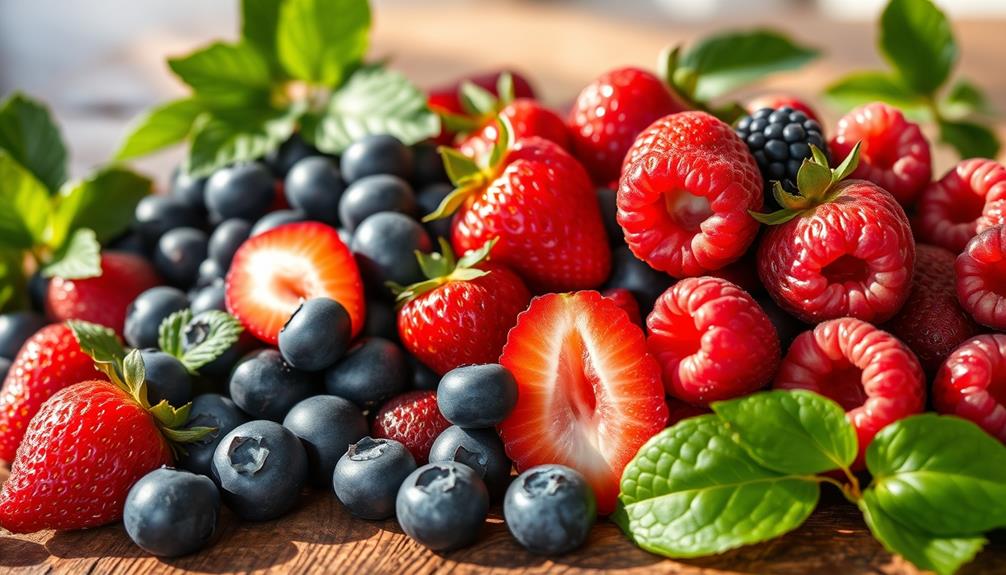You can't really eat rice on a keto diet because it's packed with carbs. A cup of cooked rice has about 45g of total carbs, well above keto limits. Even brown rice, which has a bit more fiber, isn't a suitable choice since it still disrupts ketosis. If you're trying to stay in that low-carb zone, consider alternatives like cauliflower or zucchini rice, which have considerably fewer net carbs. So, if you're curious about more options for your keto meals and want to understand better, stick around for some great ideas!
Key Takeaways
- Rice is high in carbohydrates, containing approximately 45g of total carbs per cooked cup, making it unsuitable for a keto diet.
- Both brown and white rice exceed recommended carb limits for ketosis, with similar net carb levels.
- Regular consumption of rice can disrupt ketosis; it's better to explore low-carb alternatives.
- Low-carb substitutes like cauliflower rice, zucchini rice, and Miracle Rice provide minimal to zero net carbs.
- Portion control is crucial; even small amounts of rice can impact keto progress negatively.
Understanding the Carbohydrate Content
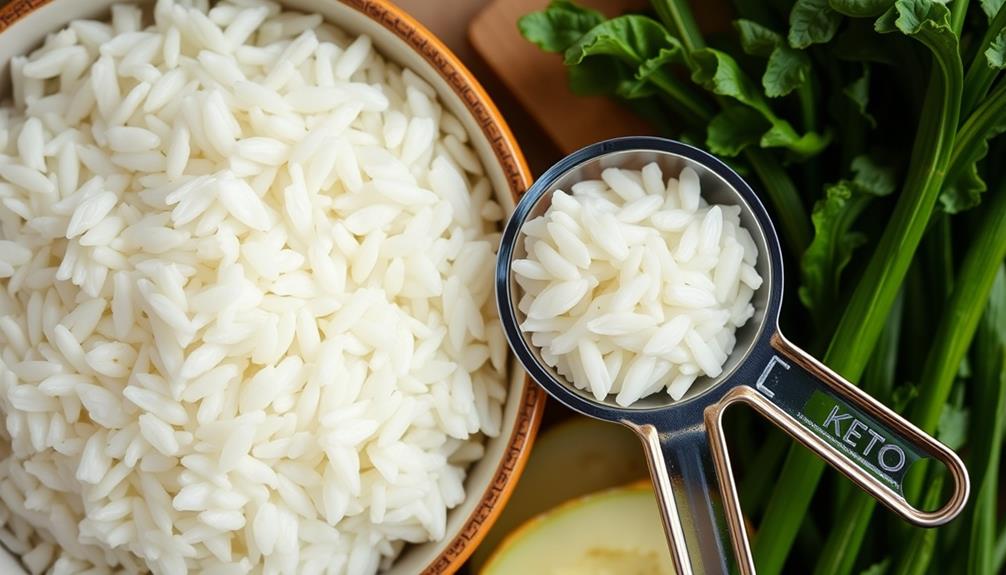
When considering a ketogenic diet, you might wonder how rice fits into your meal plan. The truth is, rice is high in carbohydrates, typically packing around 45g of carbs per cup. If you're following a strict keto diet, this could greatly disrupt your ability to maintain ketosis.
Additionally, it's essential to mention that certain foods, like celery juice benefits, can offer lower carb alternatives for hydration and nutrition. A half cup of cooked rice contains approximately 20g of net carbs, which can easily exceed your daily carb limit.
Understanding net carbs is imperative for successful carb management on keto. While brown rice has slightly more fiber than white, about 3.5g versus under 1g per cup, both options still present challenges due to their high carb content. Fiber doesn't impact ketosis, but total carbohydrate intake, including starches and sugars, does.
Regularly consuming rice can lead to exiting ketosis, so portion control becomes fundamental. If you want to stick to a low carb lifestyle, monitoring your carb content is crucial.
You'll need to weigh the risks of including rice in your diet carefully. Simply put, if you want to maintain ketosis, it's best to limit or avoid rice altogether.
Comparing Brown and White Rice
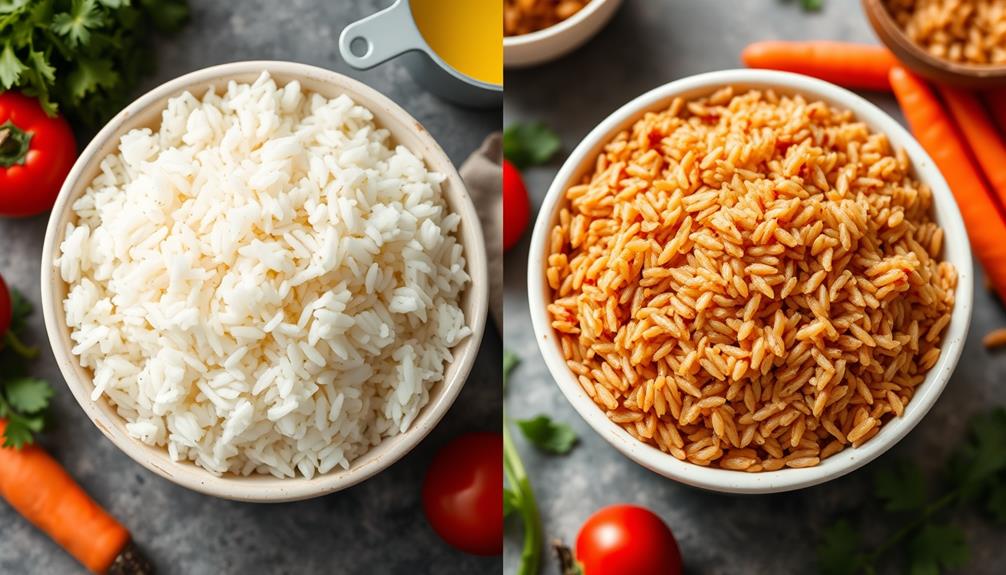
When comparing brown and white rice, you'll notice that both are high in carbs, making them less suitable for your keto diet.
While brown rice offers more fiber, it still doesn't lower the net carbs enough to keep you in ketosis.
It's important to reflect on alternative low-carb options that can provide similar textures and flavors without derailing your dietary goals.
For instance, incorporating natural remedies can help you find satisfying substitutes for rice.
Understanding these differences can help you make better choices for your low-carb meals.
Carb Content Comparison
Comparing the carb content of brown and white rice reveals that both varieties are similarly high in carbohydrates, making them unsuitable for a ketogenic diet. Brown rice contains about 45g of carbohydrates per cooked cup, while white rice is nearly the same. This means both contribute considerably to your daily carb limits.
With a half-cup serving of either type packing around 22.5g of carbs, you can easily exceed the keto guideline of 20-50g of carbs per day. To maintain ideal health while following a keto diet, it's crucial to focus on low-carb, high-fat food choices, as highlighted in effective strategies for weight loss.
Even though brown rice offers about 3.5g of fiber compared to less than 1g in white rice, this fiber doesn't sufficiently lower the net carb content. The high carb levels in both types mean they should be avoided if you want to maintain ketosis.
Instead, consider alternatives like cauliflower rice, which is much lower in carbohydrates and fits well within the constraints of a keto diet. By choosing cauliflower rice, you can enjoy a satisfying meal without compromising your ketogenic goals, ensuring you stay on track with your carb intake while still enjoying delicious food.
Nutritional Value Differences
The nutritional value differences between brown and white rice can greatly impact your diet choices, especially if you're on a keto plan. Both types contain approximately 45g of total carbohydrates per cooked cup, making them unsuitable for your carbohydrate intake if you aim to maintain a state of ketosis.
While brown rice boasts a slightly higher fiber content—about 3.5g per cup compared to under 1g in white rice—this difference doesn't markedly lower the overall carb load. In addition, understanding common financial terms can help you make informed decisions about your diet budget.
Moreover, brown rice has a lower glycemic index, leading to a slower rise in blood sugar levels. However, this benefit is minimal when you consider that both varieties still contribute to high carbohydrate intake, which can hinder ketosis.
Although many perceive brown rice as the healthier option due to its nutrient density, the reality is that both brown and white rice exceed the strict carb limits of 20-50 grams recommended for a keto diet.
Net Carbs Vs. Total Carbs
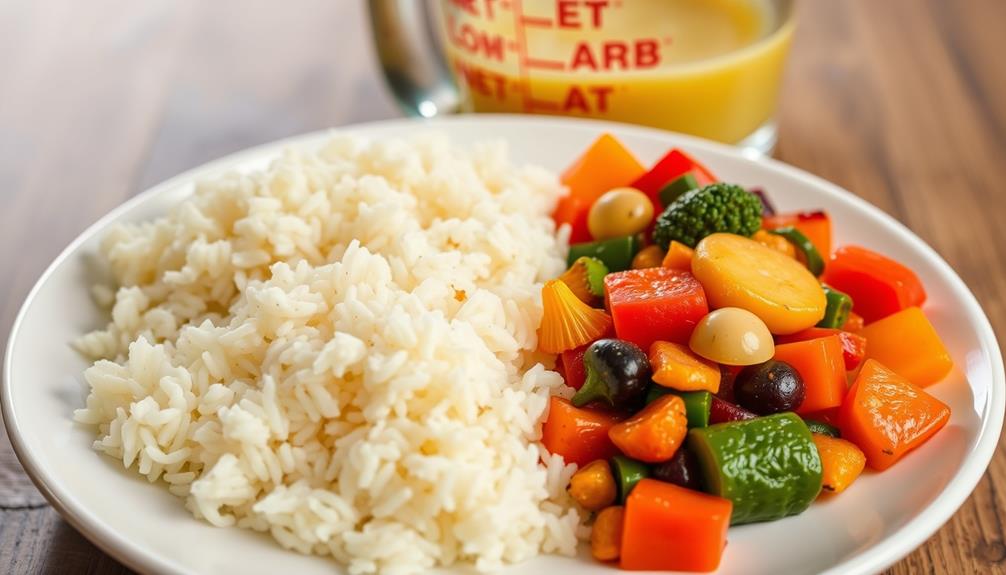
When you're tracking your carb intake on a keto diet, understanding the difference between total carbs and net carbs is essential.
Total carbs include everything, but net carbs are what really matters since they account for fiber, which doesn't impact your blood sugar.
Knowing how various foods, like coffee, can influence your carb intake is vital for maintaining ketosis, especially with different brewing methods affecting caffeine levels.
Keeping an eye on net carbs helps you stay within your daily limits and maintain ketosis.
Understanding Carb Measurements
Understanding the difference between net carbs and total carbs is essential for anyone following a keto diet, as it directly impacts your ability to maintain ketosis. Here's what you need to know:
- Total Carbohydrates: This includes all sugars, starches, and fiber in a food item. In many ways, understanding your carbohydrate intake is just as vital as knowing about best vacuums for dust removal if you're aiming to keep your living space clean and allergen-free.
- Net Carbs: Calculated by subtracting dietary fiber from total carbohydrates, since fiber doesn't affect blood sugar levels.
- Carbs Per Serving: For instance, a cup of cooked white rice has approximately 45g of total carbs, which is significant for a low-carb diet.
When you monitor net carbs, you're making informed choices that align with the strict limits of a ketogenic diet.
For example, if a food has 20g of total carbs and 5g of fiber, it contains 15g of net carbs.
Starchy foods like rice, even brown rice, can still contain around 45g of total carbs, making them unsuitable for keto.
Impact on Ketosis Levels
Maneuvering the impact of rice on your ketosis levels requires a keen awareness of both net and total carbs. Rice is high in carbs—about 45 grams per cooked cup—which can greatly hinder your ability to maintain ketosis. Even a half cup of cooked rice can add around 20 grams of carbs, dangerously close to the daily limit of 20-50 grams recommended for the keto diet.
Here's a quick comparison to illustrate the carb content:
| Type of Rice | Total Carbs (per cup) | Fiber Content | Net Carbs |
|---|---|---|---|
| White Rice | 45g | <1g | 45g |
| Brown Rice | 45g | 3.5g | 41.5g |
| Cauliflower Rice | 5g | 2g | 3g |
| Zucchini Noodles | 4g | 1g | 3g |
| Shirataki Rice | 0g | 0g | 0g |
Understanding that not all carbs are created equal is crucial. By practicing portion control and opting for low-carb alternatives, you can minimize the impact on ketosis and keep your carb intake in check.
Rice Consumption Frequency on Keto
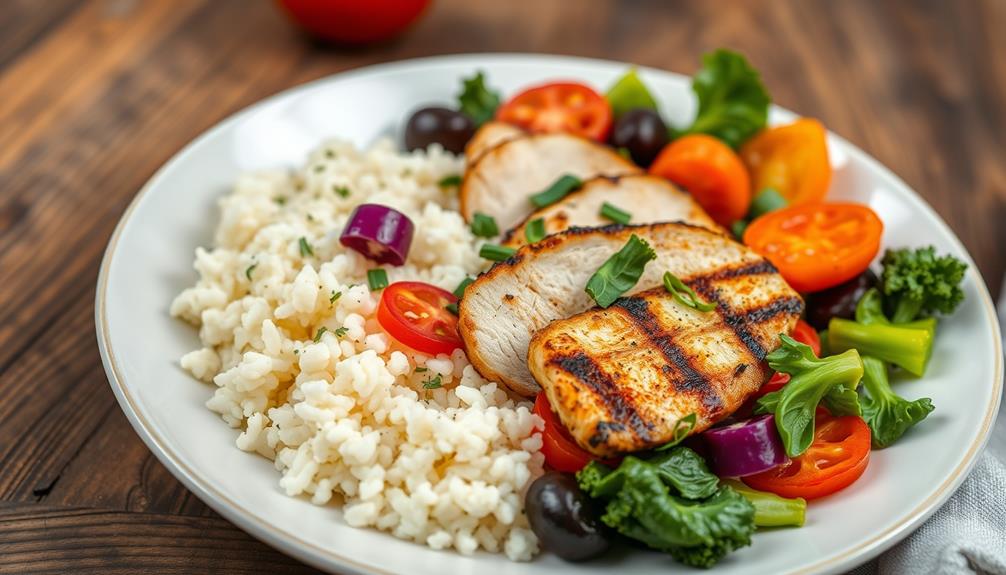
Rice isn't a staple food for those following a keto diet due to its high carbohydrate content. Regular consumption of rice, whether brown or white, isn't recommended, as it can jeopardize your efforts to maintain ketosis.
Instead, consider exploring essential oils for various health benefits that can support your wellness journey while on keto. Here's what you need to know about rice consumption frequency on keto:
- A half cup of cooked rice contributes around 20g of carbs, notably impacting your daily carb limit.
- Both brown and white rice can disrupt ketosis, containing similar net carb levels.
- It's best to limit rice to occasional small servings, if at all.
Instead of rice, consider incorporating low-carb alternatives like cauliflower rice or Miracle Rice. These options provide a similar texture without the high carbohydrate content.
By practicing portion control and focusing on low-carb alternatives, you can keep your carb intake in check and support your goal of maintaining ketosis.
Impact of Resistant Starch
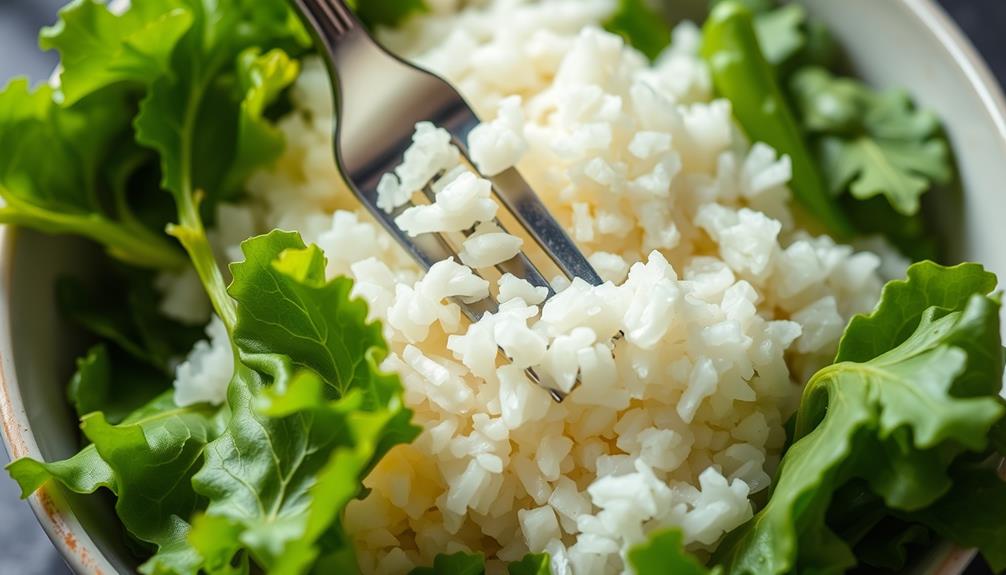
While traditional rice isn't a go-to on a keto diet, exploring the concept of resistant starch can open up some interesting possibilities. Resistant starch is a type of carbohydrate that's not fully digestible, resulting in a lower impact on blood sugar levels compared to regular starches. This makes it a potentially better option for managing carb intake while on a keto diet.
Understanding how key domains of development influence dietary choices can further enhance your approach.
Foods rich in resistant starch, like cooked and cooled potatoes, can enhance gut health and provide a feeling of fullness without causing significant spikes in blood glucose. Studies suggest that incorporating resistant starch can lead to a reduced insulin response, which may help maintain ketosis if consumed carefully.
Although cooking and cooling rice can increase its resistant starch content, it's vital to remember that rice still has a high total carbohydrate count. As a result, practicing portion control is essential.
Enjoying rice in moderation can help you avoid exceeding your daily carb limits while still benefiting from the unique properties of resistant starch. Balancing these factors can allow you to navigate your keto journey more effectively.
Keto-Friendly Rice Alternatives
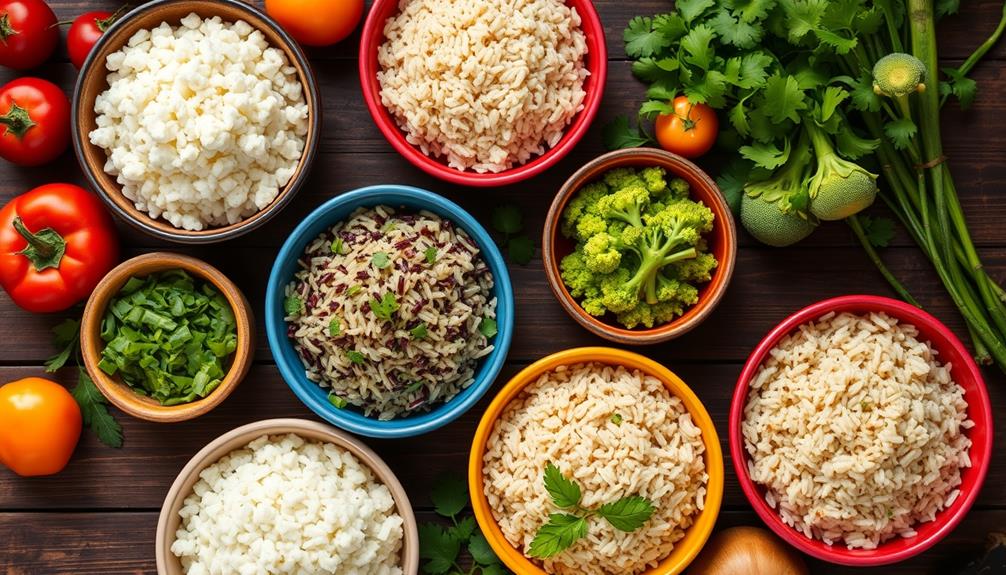
When it comes to finding satisfying substitutes for traditional rice on a keto diet, several options can fit the bill. These alternatives not only help you avoid high-carb foods but also provide nutritional benefits that align with your keto diet meal plan.
Incorporating glycolic acid's transformative effects into your skincare routine can enhance your overall health and well-being, just as choosing the right rice alternatives can support your dietary goals.
Here are three keto-friendly rice alternatives to evaluate:
- Cauliflower Rice: This popular low-carb option contains only about 5g of net carbs per cup, making it perfect for maintaining ketosis.
- Zucchini Rice: With around 3g of net carbs per cup, zucchini rice can easily be spiralized or grated to create a rice-like dish that pairs well with healthy fats.
- Broccoli Rice: Offering approximately 4g of net carbs per cup, broccoli rice adds fiber and essential vitamins to your meals.
Other great options include Miracle Rice, which has zero net carbs, and cabbage rice, which contains only about 2g of net carbs per cup.
By opting for these alternatives, you can enjoy your favorite rice dishes without compromising your keto goals or exceeding your carb limits.
Cooking Tips for Low-Carb Rice
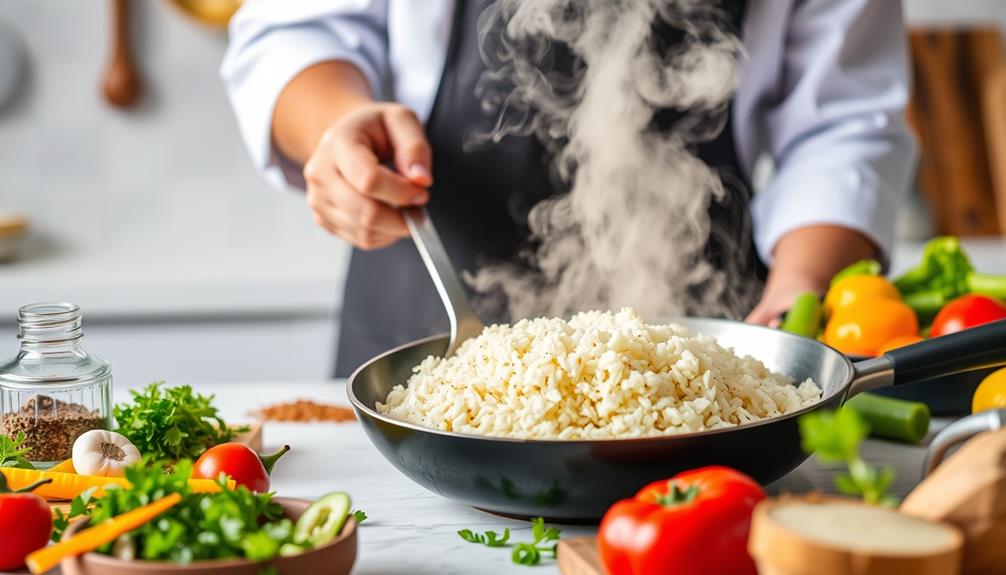
Cooking low-carb rice alternatives can be a game changer for your keto meals. By using cauliflower rice or Miracle Rice, you can greatly cut down on carbs while still enjoying a rice-like texture. Here are some cooking tips to enhance your low-carb rice experience:
| Low-Carb Rice Alternative | Key Benefits |
|---|---|
| Cauliflower Rice | Only 5 grams of carbs per cup |
| Miracle Rice | Zero net carbs, 10 calories per serving |
When preparing cauliflower rice, pulse the cauliflower florets in a food processor until they resemble traditional rice grains. This step is essential for achieving the right consistency. Sauté the resultant cauliflower rice in olive oil to boost the flavor while keeping it keto-friendly.
For added taste, don't forget to mix in herbs and spices like garlic powder, onion powder, or nutritional yeast. These ingredients can elevate the dish, making it a satisfying part of your meal plan. With these tips, you'll find that low-carb rice alternatives can seamlessly fit into your keto lifestyle!
Final Thoughts on Rice and Keto

Is rice worth the risk on a keto diet? Given its high carb content, rice, whether brown or white, can quickly consume your carb allotment and derail your journey to ketosis.
Additionally, it's crucial to think about the overall impact of your food choices on financial health, much like evaluating the risks and rewards of Bitcoin IRAs.
Here are three key points to reflect on:
- Net Carbs Matter: Both brown and white rice have around 45g of total carbs per cooked cup, exceeding typical net carb limits for keto dieters.
- Starchy Alternatives: Instead of traditional rice, opt for low-carb substitutes like cauliflower rice or Miracle Rice, which offer minimal to zero net carbs.
- Portion Control: If you choose to indulge, be mindful of portion control, as even small amounts of rice can impact your progress.
While brown rice may seem like a healthier option due to its fiber content, it still poses a risk for maintaining ketosis.
Avoid processed foods that can sneakily add excess carbs to your diet.
By focusing on low-carb substitutes and starchy vegetables that fit within your daily limits, you can enjoy satisfying meals while sticking to your keto goals. Additionally, incorporating ketofriendly vegetables such as zucchini, cauliflower, and spinach can provide essential nutrients without spiking your carbohydrate intake. These vegetables not only make for versatile ingredients in various dishes but also help you stay full and energized throughout the day. With the right combinations, you can maintain variety in your diet and continue to meet your keto objectives.
Ultimately, it revolves around making choices that align with your commitment to the ketogenic lifestyle.
Frequently Asked Questions
What Kind of Rice Can I Eat on Keto?
If you're following a keto diet, traditional rice isn't suitable due to its high carb content. Instead, try cauliflower rice or Miracle Rice; they're delicious alternatives that keep you in ketosis without the excess carbs.
What Grains Can You Eat on Keto?
On keto, you can enjoy alternatives like cauliflower rice, zucchini noodles, and flaxseeds. You'll find these low-carb options not only satisfy your cravings but also support your goals while keeping your carb intake in check.
Will One Bite of Rice Kick Me Out of Ketosis?
One bite of rice can jeopardize your ketosis. With its high carb content, even a small amount might push you over your daily limit, causing your body to switch back to using glucose for energy.
Can You Eat Brown Rice on a Keto Diet?
You can't eat brown rice on a keto diet. It's high in carbs, disrupts ketosis, and risks exceeding your daily limit. Instead, consider low-carb alternatives like cauliflower rice to maintain your ketogenic lifestyle effectively.
Conclusion
To sum up, while traditional rice is high in carbs and generally not suitable for a keto diet, understanding your options can help you stay on track. For instance, did you know that one cup of cooked white rice contains about 45 grams of carbs? Instead, consider alternatives like cauliflower rice or shirataki rice, which can satisfy your cravings without jeopardizing your ketosis. With the right substitutes and cooking tips, you can enjoy delicious meals while keeping your carb count low.
